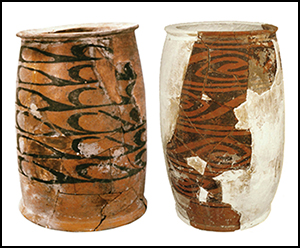Crossref Citations
This article has been cited by the following publications. This list is generated based on data provided by
Crossref.
2017.
ANNUAL BIBLIOGRAPHY.
Early China,
Vol. 40,
Issue. ,
p.
333.
Drennan, Robert D.
Peterson, Christian E.
Lu (吕学明), Xueming
and
Li (李涛), Tao
2017.
Hongshan households and communities in Neolithic northeastern China.
Journal of Anthropological Archaeology,
Vol. 47,
Issue. ,
p.
50.
Hayden, Brian
2018.
The Power of Ritual in Prehistory.
Jacob Skousen, B
2018.
Rethinking archaeologies of pilgrimage.
Journal of Social Archaeology,
Vol. 18,
Issue. 3,
p.
261.
Shelach-Lavi, Gideon
Teng, Mingyu
Goldsmith, Yonaton
Wachtel, Ido
Stevens, Chris J.
Marder, Ofer
Wan, Xiongfei
Wu, Xiaohong
Tu, Dongdong
Shavit, Roi
Polissar, Pratigya
Xu, Hai
Fuller, Dorian Q.
and
Yang, Xiaoyan
2019.
Sedentism and plant cultivation in northeast China emerged during affluent conditions.
PLOS ONE,
Vol. 14,
Issue. 7,
p.
e0218751.
Drennan, Robert D.
Peterson, Christian E.
and
Berrey, C. Adam
2020.
Environmental risk buffering in Chinese Neolithic villages: Impacts on community structure in the Central Plains and the Western Liao Valley.
Archaeological Research in Asia,
Vol. 21,
Issue. ,
p.
100165.
Li, Tao
Ning, Chao
Zhushchikhovskaya, Irina S.
Hudson, Mark J.
and
Robbeets, Martine
2020.
Millet agriculture dispersed from Northeast China to the Russian Far East: Integrating archaeology, genetics, and linguistics.
Archaeological Research in Asia,
Vol. 22,
Issue. ,
p.
100177.
Sebillaud, Pauline
Williams, James
Liu, Xiaoxi
and
Wang, Lixin
2021.
Changing settlement patterns and subsistence strategies in Northeast China: Results of the Yueliang regional survey.
Archaeological Research in Asia,
Vol. 25,
Issue. ,
p.
100250.
Wang, Wenjing
and
Wu, Weihong
2021.
Lingjiatan early complex societies and social organization in the Yuxi Valley, China.
Archaeological Research in Asia,
Vol. 25,
Issue. ,
p.
100259.
Berrey, C. Adam
Drennan, Robert D.
Peterson, Christian E.
and
Freeman, Jacob
2021.
Local economies and household spacing in early chiefdom communities.
PLOS ONE,
Vol. 16,
Issue. 5,
p.
e0252532.
Jaffe, Yitzchak
2023.
Food in Ancient China.
Larrivé-Bass, Sandrine
2023.
Jade for Bones in Hongshan Craftsmanship: Human Anatomy as the Genesis of a Prehistoric Style.
Arts,
Vol. 12,
Issue. 5,
p.
206.
